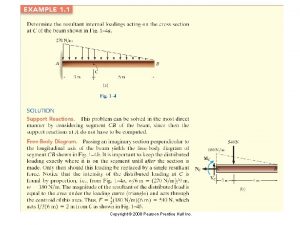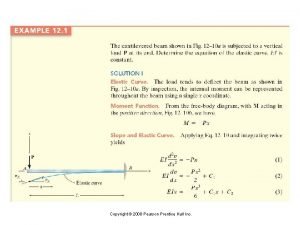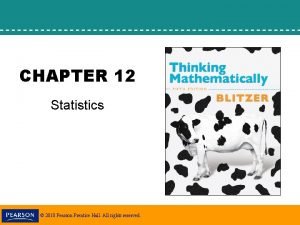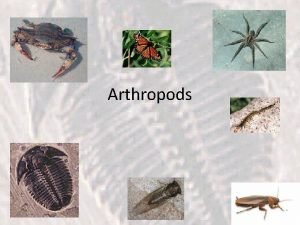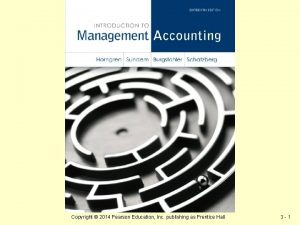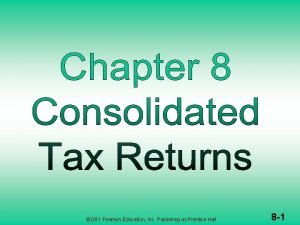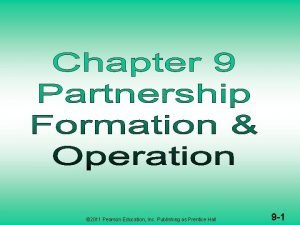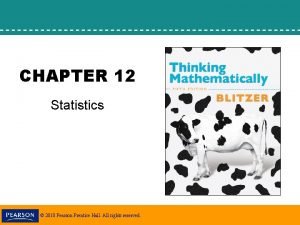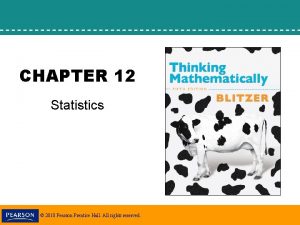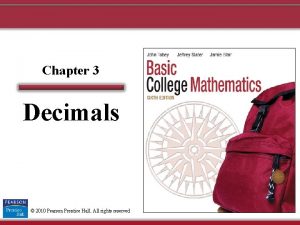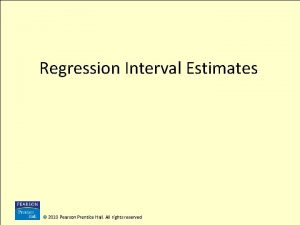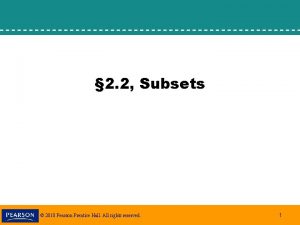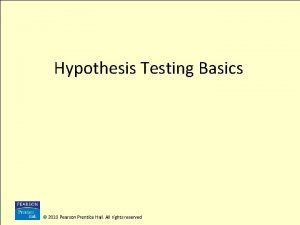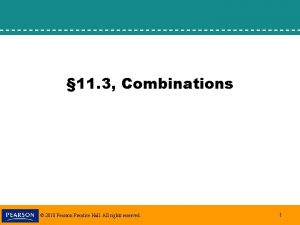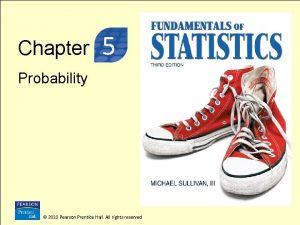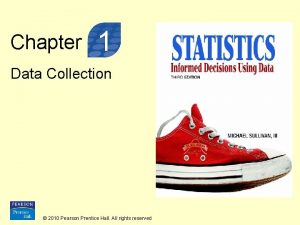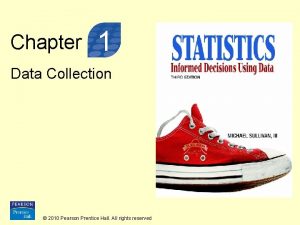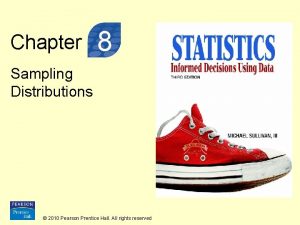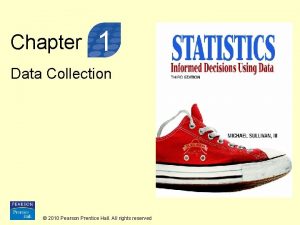CHAPTER 12 Statistics 2010 Pearson Prentice Hall All
















- Slides: 16

CHAPTER 12 Statistics © 2010 Pearson Prentice Hall. All rights reserved.

12. 6 Scatter Plots, Correlation, and Regression Lines © 2010 Pearson Prentice Hall. All rights reserved. 2

Objectives 1. Make a scatter plot for a table of data items. 2. Interpret information given in a scatter plot. 3. Compute the correlation coefficient. 4. Write the equation of the regression line. 5. Use a sample’s correlation coefficient to determine whethere is a correlation in the population. © 2010 Pearson Prentice Hall. All rights reserved. 3

Scatter Plots and Correlation • A scatter plot is a collection of data points, one data point person or object. • Can be used to determine whether two quantities are related. • Correlation – a clear relationship between two quantities. – used to determine if there is a relationship between two variables and, if so, the strength and direction of that relationship. © 2010 Pearson Prentice Hall. All rights reserved. 4

Scatter Plots and Correlation • The scatter plot shows a downward trend among the data points, with some exceptions. • People with increased education tend to have a lower score on the test measuring prejudice. © 2010 Pearson Prentice Hall. All rights reserved. 5

Correlation and Causal Connections Although the scatter plot shows a correlation between education and prejudice, we cannot conclude that increased education causes a person’s level of prejudice to decrease. 1. The correlation could be simply a coincidence. 2. Education usually involves classrooms with a variety of different kinds of people. Increased exposure to diversity in the classroom might be an underlying cause. 3. Education requires people to look at new ideas and see things in different ways. Thus, education causes one to be more tolerant and less prejudiced. © 2010 Pearson Prentice Hall. All rights reserved. 6

Regression Lines • Regression line is a line that best fits the data points in a scatter plot. © 2010 Pearson Prentice Hall. All rights reserved. 7

Correlation Coefficients • Correlation coefficient, designated by r, is a measure that is used to describe the strength and direction of a relationship between variables whose data points lie on or near a line. The relationship is: – Positively correlated if they tend to increase or decrease together. – Negatively correlated if one variable tends to decrease while the other increases. – Perfect positive correlation in which all points lie precisely on the regression line that rises from left to right. – Perfect negative correlation in which all points in the scatter point lie precisely on the regression line that falls from left to right. © 2010 Pearson Prentice Hall. All rights reserved. 8

Scatter Plots and Correlation Coefficients © 2010 Pearson Prentice Hall. All rights reserved. 9

Computing the Correlation Coefficient The following formula is used to calculate the correlation coefficient, r: © 2010 Pearson Prentice Hall. All rights reserved. 10

Computing the Correlation Coefficient In the formula: n = the number of data points, (x, y) Σx = the sum of the x-values Σy = the sum of the y-values Σxy = the sum of the product of x and y in each pair Σx² = the sum of the squares of the x-values Σy² = the sum of the squares of the y-values (Σx)² = the square of the sum of the x-values (Σy)² = the square of the sum of the y-values © 2010 Pearson Prentice Hall. All rights reserved. 11

Example 2: Computing the Correlation Coefficient Shown below are the data involving the number of years of school, x, completed by 10 randomly selected people and their scores on a test measuring prejudice, y. Determine the correlation coefficient between years of education and scores on a prejudice test. Respondent Years of education (x) Score on prejudice test (y) A B C D E F G H I J 12 5 14 13 8 10 16 11 12 4 1 7 © 2010 Pearson Prentice Hall. All rights reserved. 2 3 5 4 1 2 3 10 12

Example 2 continued x 12 5 14 13 8 10 16 11 12 4 Σx = 105 y 1 7 2 3 5 4 1 2 3 10 Σy = 38 xy x² 12 144 35 25 28 196 39 169 40 64 40 100 16 256 22 121 36 144 40 16 Σxy = 308 Σx² = 1235 © 2010 Pearson Prentice Hall. All rights reserved. y² 1 49 4 9 25 16 1 4 9 100 Σy² = 218 13

Example 2 continued (Σx)² = 11, 025 (Σy)² = 1444 Calculating r: © 2010 Pearson Prentice Hall. All rights reserved. 14

Formula © 2010 Pearson Prentice Hall. All rights reserved. 15

Example 3: Writing the Equation of the Regression Line To find the regression line for the previous data: Σx = 105 Σy = 38 Σxy = 308 Σx² = 1235 Σy² = 218 The equation of the regression line is y = − 0. 69 x + 11. 05 © 2010 Pearson Prentice Hall. All rights reserved. 16
 Pearson education 2011
Pearson education 2011 2011 pearson education inc
2011 pearson education inc Pearson education inc publishing as pearson prentice hall
Pearson education inc publishing as pearson prentice hall Pearson education inc publishing as pearson prentice hall
Pearson education inc publishing as pearson prentice hall Pearson education inc publishing as pearson prentice hall
Pearson education inc publishing as pearson prentice hall Prentice hall inc
Prentice hall inc 2008 pearson prentice hall inc
2008 pearson prentice hall inc 2005 pearson prentice hall inc
2005 pearson prentice hall inc Pearson prentice hall
Pearson prentice hall Pearson prentice hall
Pearson prentice hall Pearson prentice hall
Pearson prentice hall 2005 pearson prentice hall inc
2005 pearson prentice hall inc Arthropoda common name
Arthropoda common name Pearson education inc. publishing as prentice hall
Pearson education inc. publishing as prentice hall 2012 pearson education inc
2012 pearson education inc Pearson education inc. publishing as prentice hall
Pearson education inc. publishing as prentice hall 2011 pearson education inc
2011 pearson education inc





